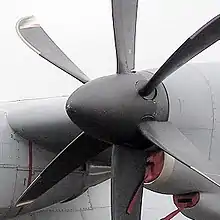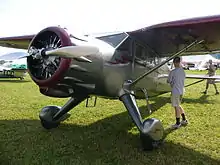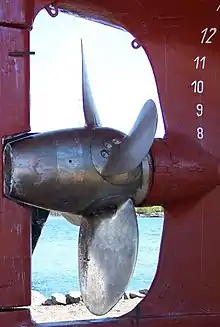Variable-pitch propeller
A variable-pitch propeller or controllable-pitch propeller (CPP) is a type of propeller with blades that can be rotated around their long axis to change the blade pitch. Reversible propellers—those where the pitch can be set to negative values—can also create reverse thrust for braking or going backwards without the need to change the direction of shaft revolution.
Aircraft


Propeller-driven aircraft use propellers with adjustable blade pitch to adapt the propeller to different thrust levels and air speeds so that the propeller blades do not stall, hence degrading the propulsion system's efficiency. Especially when cruising, an engine can operate in its most economical range of rotational speeds. With the exception of going into reverse for braking after touch-down, the pitch is usually controlled automatically without the pilot's intervention. A propeller with a controller that adjusts the blade pitch so that the rotational speed always stays the same is called a constant-speed propeller. A propeller with controllable pitch can have a nearly constant efficiency over a range of airspeeds.[1]
Development
A number of early aviation pioneers, including A. V. Roe and Louis Breguet, used propellers that could only be adjusted while the aircraft was on the ground[2] - this also happened late in World War I with one testbed example, "R.30/16", of the low-production (56 examples in 1917 and 1918) Zeppelin-Staaken R.VI German "giant" four-engined heavy bomber.[3] In 1919 L. E. Baynes patented the first automatic variable-pitch airscrew.
The French aircraft firm Levasseur displayed a variable-pitch propeller at the 1921 Paris Airshow. The firm claimed that the French government had tested the device in a ten-hour run and that it could change pitch at any engine RPM.[4]
Dr Henry Selby Hele-Shaw and T.E. Beacham patented a hydraulically-operated variable-pitch propeller (based on a variable-stroke pump) in 1924 and presented a paper on the subject before the Royal Aeronautical Society in 1928; it met with scepticism as to its utility.[5] The propeller had been developed with Gloster Aircraft Company as the Gloster Hele-Shaw Beacham Variable Pitch Propellor and was demonstrated on a Gloster Grebe, where it was used to maintain a near-constant RPM.[6]
The first practical controllable-pitch propeller for aircraft was introduced in 1932.[7] French firm Ratier pioneered variable-pitch propellers of various designs from 1928 onwards, relying on a special ball-bearing helicoidal ramp at the root of the blades for easy operation.
Several designs were tried, including a small bladder of pressurized air in the propeller hub providing the necessary force to resist a spring that would drive the blades from fine pitch (take-off) to coarse pitch (level cruising). At a suitable airspeed a disk on the front of the spinner would press sufficiently on the bladder's air-release valve to relieve the pressure and allow the spring to drive the propeller to coarse pitch. These "pneumatic" propellers were fitted on the DH88 Comet aircraft, winner of the famed long-distance 1934 Mac Robertson race and in the Caudron C.460 winner of the 1936 National Air Races, flown by Michel Détroyat. Use of these pneumatic propellers required presetting the propeller to fine pitch prior to take-off. This was done by pressurizing the bladder with a bicycle pump, hence the whimsical nickname Gonfleurs d'hélices (prop-inflater boys) given to the aircraft ground-mechanics in France up to this day.[8]
A common type of controllable-pitch propeller is hydraulically actuated; Frank W. Caldwell of the Hamilton Standard Division of the United Aircraft Company originally developed this design, which led to the award of the Collier Trophy of 1933.[9] De Havilland subsequently bought up the rights to produce Hamilton propellers in the UK, while Rolls-Royce and Bristol Engines formed the British company Rotol in 1937 to produce their own designs. The French company of Pierre Levasseur and Smith Engineering Co. in the United States also developed controllable-pitch propellers. Wiley Post (1898-1935) used Smith propellers on some of his flights.
Another common type was originally developed by Wallace Turnbull and refined by the Curtiss-Wright Corporation.[10] This electrically-operated mechanism, first tested in on June 6, 1927 at Camp Borden, Ontario, Canada, received a patent in 1929 (U.S. Patent 1,828,348). Some pilots in World War II (1939-1945) favoured it, because even when the engine was no longer running the propeller could be feathered. On hydraulically-operated propellers the feathering had to happen before the loss of hydraulic pressure in the engine.
As experimental aircraft and microlights have become more sophisticated, it has become common for such light aeroplanes to feature variable-pitch propellers, both ground-adjustable propellers and in-flight-variable propellers. Hydraulic operation is too expensive and bulky; instead, light aircraft use propellers that are activated mechanically or electrically.
Ships

A controllable pitch propeller (CPP) can be efficient for the full range of rotational speeds and load conditions, since its pitch will be varied to absorb the maximum power that the engine is capable of producing. When fully loaded, a vessel will need more propulsion power than when empty. By varying the propeller blades to the optimal pitch, higher efficiency can be obtained, thus saving fuel. A vessel with a VPP can accelerate faster from a standstill and can decelerate much more effectively, making stopping quicker and safer. A CPP can also improve vessel maneuverability by directing a stronger flow of water onto the rudder.[11]
However, a fixed variable-pitch propeller (FVPP) is both cheaper and more robust than a CPP. Also, an FVPP is typically more efficient than a CPP for a single specific rotational speed and load condition. Accordingly, vessels that normally operate at a standard speed (such as large bulk carriers, tankers and container ships) will have an FVPP optimized for that speed. At the other extreme, a canal narrowboat will have a FVPP for two reasons: speed is limited to 4 mph (to protect the canal bank), and the propeller needs to be robust (when encountering underwater obstacles).
Vessels with medium or high speed diesel or gasoline engines use a reduction gear to reduce the engine output speed to an optimal propeller speed—although the large low speed diesels, whose cruising RPM is in the 80 to 120 range, are usually direct drive with direct-reversing engines. While an FVPP-equipped vessel needs either a reversing gear or a reversible engine to reverse, a CPP vessel may not. On a large ship the CPP requires a hydraulic system to control the position of the blades. Compared to an FPP, a CPP is more efficient in reverse as the blades' leading edges remain as such in reverse also, so that the hydrodynamic cross-sectional shape is optimal for forward propulsion and satisfactory for reverse operations.
In the mid-1970s, Uljanik Shipyard in Yugoslavia produced four VLCCs with CPPs – a tanker and three ore/oil carriers – each powered by two 20,000 bhp B & W diesel engines directly driving Kamewa variable-pitch propellers. Due to the high construction cost none of these vessels ever returned a profit over their lifetimes. For these vessels, fixed variable-pitch propellers would have been more appropriate.[12]
Controllable-pitch propellers are usually found on harbour or ocean-going tugs, dredgers, cruise ships, ferries, cargo vessels and larger fishing vessels. Prior to the development of CPPs, some vessels would alternate between "speed wheel" and "power wheel" propellers depending on the task. Current VPP designs can tolerate a maximum output of 44000 kW (60,000 hp).
Sail boats
A sailboat or motorsailer when voyaging on sail alone will benefit from reduced drag, and just like an aeronautical propeller, a marine VPP may be "feathered" to give the least water resistance when sailing without using power. A VPP is particularly useful when motorsailing (i.e. voyaging under both power and sail), as the VPP can be coarsened to incorporate the wind component. If the prop remained at the "normal" setting, it would be too fine and the engine would provide little useful contribution; but by coarsening the prop, the engine provides useful thrust, resulting in a higher speed yet reduced fuel consumption because of the sailing component. resistance.
See also
References
- Lutze (5 May 2011). "Level flight performance" (PDF). The Department of Aerospace and Ocean Engineering, Virginia Tech. p. 8. Archived from the original (PDF) on 20 July 2011. Retrieved 2011-01-06.
- Aeroplane propellers Archived 2013-02-10 at the Wayback MachineFlight International 9 January 1909
- Haddow, G.W.; Grosz, Peter (1988). The German Giants – The German R-Planes 1914-1918 (3rd ed.). London: Putnam & Company Ltd. pp. 242–259. ISBN 0-85177-812-7.
- "Pierre Levasseur". Flight. November 17, 1921. p. last paragraph on page 761. Archived from the original on November 3, 2012. Retrieved 2012-09-09.
- "Aircraft gear box". Flight. August 14, 1941. p. 86. Archived from the original on November 5, 2012. Retrieved 2012-09-09.
- "The Gloster Hele-Shaw Beacham Variable Pitch Propeller". Flight. October 11, 1928. pp. 14–15. Archived from the original on February 8, 2015. Retrieved 2012-09-09.
- ""Gear Shift" for Airplanes Seen in Adjustable Prop", Popular Mechanics, Hearst Magazines, p. 951, December 1932, retrieved 9 November 2020
- Decombeix, PM. "La Maison Ratier : les hélices Ratier métalliques." www.ratier.org. Archived from the original on 12 November 2017. Retrieved 4 April 2018.
- "Aeronautics: Award No. 3". Time. June 4, 1934. Archived from the original on November 4, 2012. Retrieved 2012-09-09.
- "The Turnbull Variable Pitch Propeller". Flight. May 13, 1932. pp. 419–420. Archived from the original on March 6, 2016. Retrieved 2013-03-05.
- Kasten, Michael. "Controllable Pitch Propellers". www.kastenmarine.com. Archived from the original on 23 March 2018. Retrieved 4 April 2018.
- "Controllable pitch propeller - My First JUGEM!". My First JUGEM!. Archived from the original on 14 June 2018. Retrieved 4 April 2018.
External links
- 1941 Cutaway Drawing of Hydromatic Variable Pitch Propeller Operation on B-24 bomber
- Contemporary discussion of merits of variable-pitch propellers in Flight magazine 1935
- CONTROLLABLE-PITCH AIRSCREWS explained in Flight 2 May 1935 and 9 May 1935